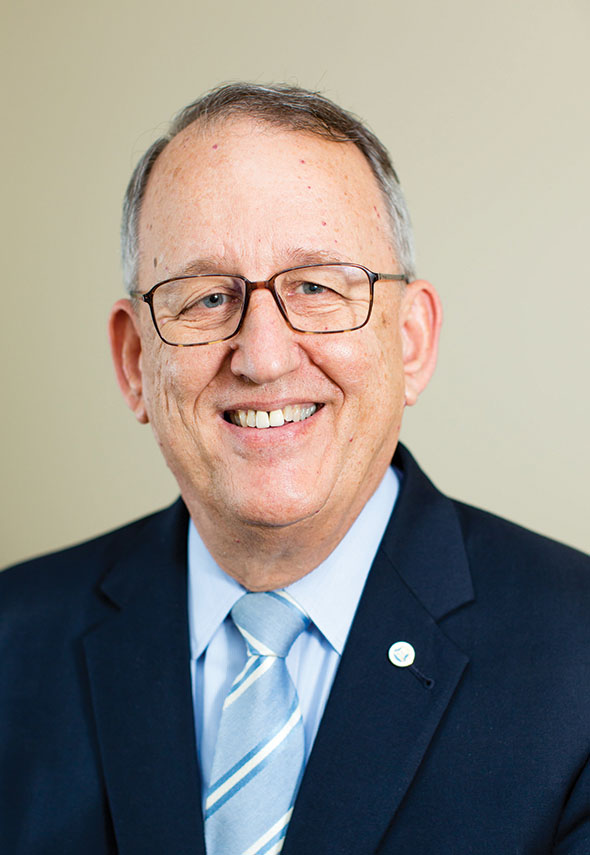Marking Milestones: The GAA at 175
Posted on April 30, 2018From its first days, the UNC General Alumni Association has aspired to connect and reconnect Carolina alumni with their University — both with the place and the people who call it alma mater. Here is a selection of key points over its 175-year history:
1843 At Commencement, Gov. John Motley Morehead (class of 1817) is selected as the association’s first volunteer leader. The gathering of 31 alumni includes two future N.C. governors: Charles Manly (class of 1814) and William A. Graham (class of 1824).

Douglas S. Dibbert ’70
1844 A constitution is adopted setting out the association’s purposes: Perpetuate the friendships formed in the collegiate course, promote the welfare of alma mater, and promote the cause of education generally. Faculty member Charles Phillips is selected as the GAA’s first secretary, serving until after the University closes during Reconstruction.
1846 At Commencement, President James K. Polk (class of 1818) makes a motion that launches a campaign to erect a monument to UNC’s first president, Joseph Caldwell. The monument is dedicated 12 years later.
1850 Trustees vote to fund a building (Smith Hall) for a dining hall, ballroom and room for use by the trustees and the alumni association.
1855 Class reunions are added to annual meeting at Commencement.
1888 Josephus Daniels (class of 1885) is elected GAA secretary. Committees form to arrange for reunions for the 1889 Commencement.
1889 Alumni banquets begun in Gerrard Hall continue at Commencement. Reunion attendees endow a chair in history.
1890 “Branch associations” exist in Wake County, Goldsboro, Wilmington, Charlotte, Washington, Durham, Craven County, Winston-Salem and High Point.
1895 By Commencement, the Alumni Quarterly and the University Record have appeared; a fundraising drive is underway to build Alumni Hall.
1899 The New York alumni chapter first meets.
1910 Alumni banquets are held in Raleigh, Wilmington, Durham, Williamston, Charlotte, Oxford, High Point, Wilson, Windsor, Salisbury, Winston-Salem, Red Springs, Mooresville and Norfolk; 30 branch associations report to the Commencement assembly.
1912 The Alumni Review is founded with Louis Round Wilson (class of 1899) as editor.
1922 Daniel L. Grant (class of 1921) is hired as the association’s full-time executive secretary. He also edits the Alumni Review and the Alumni History of The University Of North Carolina 1795–1924, containing the names of 15,000 alumni. Annual dues are $3.
1927 J. Maryon “Spike” Saunders (class of 1925) succeeds Grant, serving until 1970. In addition to being alumni secretary and editor of the Review, in 1952 Saunders helps launch, with the University, Alumni Annual Giving. When Saunders moves the GAA’s offices from South Building to The Carolina Inn, a total of 17,700 alumni have matriculated at UNC.
1943 The GAA celebrates its centennial. James Lee Love (class of 1884) establishes the Cornelia P. Spencer Alumni Fund that endows two things: the Old Students Club annual luncheon, and the maintenance and periodic publication of a register of University alumni.
1954 The first Alumni Directory (1795–1953) is published, listing 61,877 living and deceased graduates and other ex-matriculates. (Over the next six decades, seven more directories are published; the 2015 edition lists 371,000 living and deceased alumni.)
1970 Clarence E. Whitefield ’44 succeeds Saunders. In 1971, he helps start the GAA’s travel program, and GAA offices move into Alumni House; and in 1978 the GAA’s first Distinguished Service Medals are awarded.
1980 The Black Alumni Reunion and the Order of the Bell Tower are founded.
1982 Douglas S. Dibbert ’70 succeeds Whitefield.
1983 The GAA launches a public-policy advocacy program, Tar Heel Network. For two years, Brevard is home to a weeklong Camp Blue Heaven; the camp resumes in 1995 as a weekend program at Camp Cheerio.
1986 George Watts Hill (class of 1922) makes a $3.5 million challenge gift to construct what will become a 65,000-square-foot Alumni Center. More than 14,000 alumni and friends contribute more than $12.5 million. The GAA begins sponsoring the Clef Hangers.
1989 The first GAA Faculty Service Award is presented, to H.G. Jones, curator of the N.C. Collection.
1990 The first Distinguished Young Alumni Awards are presented, to James H.S. Cooper ’75 and Rebecca Wesson Darwin ’75.
1992 Alumni career services programming begins.
1993 The George Watts Hill Alumni Center and The Carolina Club open. The GAA begins sponsoring the Loreleis.
2001 The GAA Scholars launches with a $500,000 gift to the University.
2005 The Black Alumni Reunion’s Light on the Hill Scholarships are established.
2012 The Carolina Alumni Review publishes its centennial issue.
2018 The 50,000th life membership number is assigned; 393,884 records of living and deceased alumni are maintained. For 22 years in a row, from 1996 to 2018, the GAA is recognized with national or district CASE awards, earning 114 in all.
Yours at Carolina,

Douglas S. Dibbert ’70
